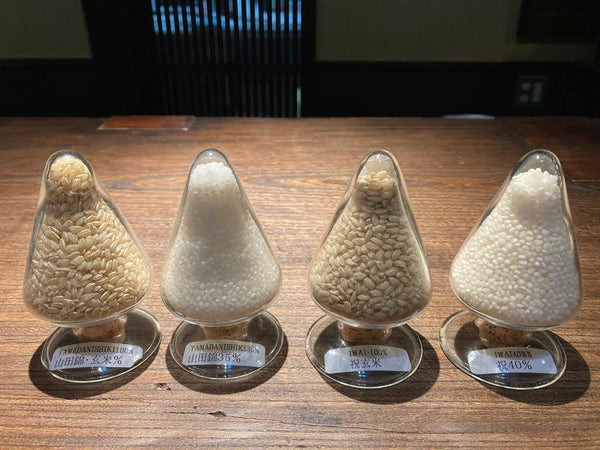
Jump to:
Sake is commonly referred to as ‘rice wine’ in the West. When you hear ‘rice wine’ do you think of a beverage that contains both rice and grapes? In the case of sake, no grapes are used in its production, but rice does play an extremely important role in making sake. In fact, rice is one of the only ingredients used in its preparation. Since rice has such a large role in sake making, the kind of rice used makes a big difference in the flavor, right? Correct!
When it comes to sake, there are actual varieties of rice that were created solely for the purpose of sake making. While there are types of sake using consumption-grade rice on the market, the tastiest, or creme de la creme sake are said to be made using rice specially produced for sake. On top of that, there are two kinds of sake rice that have been crowned as the king and queen for sake making. These varieties are known as Yamada Nishiki and Gohyakumangoku, respectively.
In this blog post, we’ll highlight:
- Why these two Sake Rice varieties have claimed to be King and Queen
- An Overview of Yamada Nishiki Rice
- An Overview of Gohyakumangoku Rice
- Which Sake should you pick?
Why the king and queen of sake rice?
Why are Yamada Nishiki and Gohyakumangoku the so-called king and queen of sake rice? Well, the answer lies in the fact that both of these varieties were created with an intent to be used only in sake production. Therefore, Yamada Nishiki and Gohyakumangoku have been produced to have not only, what is believed to be the ideal flavor-profile(s) for sake, but the rice grains themselves also contain a high starch content or what is also known as good ‘shimpaku’. The king and queen of sake rice have many common strong points, but at the end of the day, they are still two different varieties of rice. Each of these sake rices will provide sake with different flavor profiles. In this article, we will look at both the Yamada Nishiki and Gohyakumangoku varieties of rice, and investigate their key qualities, to understand their similarities yet differences.
Yamada Nishiki Rice
First, let’s take a look at the king of sake rice himself, Yamada Nishiki. This rice is sought out by many sake makers across Japan because it has a unique ability to give sake a clean taste, yet not be too light bodied. But, how do sake brewers automatically know that their sake will come out clean tasting by using Yamada Nishiki rice? If we think about how wine producers seek out the highest quality wine grapes for producing flavorful varieties of wine, this same philosophy can be applied for yielding premium-grade, delicious sake. By using the Yamada Nishiki rice for making sake, sake producers can be assured that their final sake product will have a flavor that is fruity, fragrant, and complex in flavor - aka the ideal flavor profile for sake.
So, what gives Yamada Nishiki rice the potential to deliver such a tasty sake product? The answer lies in the grains of the rice themselves. The grains of Yamada Nishiki rice are bigger than standard Japanese rice grains, and are also quite soft, allowing them to absorb water easily. When making sake, brewers want to use a rice grain that is on the softer side because it will be starchier. Yamada Nishiki rice grains were also developed to have a lower content of fat and protein, and as mentioned, a higher amount of starch. The starch in these grains are also stored at the center of the grain - causing the rice to have good ‘shimpaku’ - or ratio of starch per rice grain. The profile of these rice grains allow the rice to be easily polished, leaving behind the starchy bit still intact. The starch content in the grains also allow for easier absorption, giving the end product of sake a much more concentrated ‘rice umami' flavor.

Image: SakeTimes
As shown in this diagram, the inner part of the rice grain is the starch, also known as the shimpaku of the rice grain. Rice grains that contain a good shimpaku are highly sought after by sake makers. The starchiness of the rice is what gives the sake its clean, yet umami flavor.
Growing Conditions of Yamada Nishiki Rice

This variety of rice is not easy to grow as it requires specific growing conditions that cannot be found easily in Japan. Yamada Nishiki rice stands out with its tall height - that of 107 centimeters - and larger than average grains. It is a fragile crop that can be knocked over by wind easily, so it cannot be grown on flat land. Due to these conditions, Yamada Nishiki rice can only be grown in areas which meet all of the requirements for growing conditions. Interestingly, most of its production happens in Hyogo prefecture, which neighbors Kyoto and Osaka. The birthplace of Yamada Nishiki rice is also in Hyogo prefecture. The hilly-environment of Hyogo allows for Yamada Nishiki crops to thrive. Farmers in Hyogo growing this prized rice must make sure to shelter their crops from wind. However, due to the sloping range of these crop areas, Yamada Nishiki rice paddies are quite small.

We can conclude that this premium grade of rice is enjoyed in a variety of high quality sake, as it yields flavorful yet clean tasting results.
Gohyakumangoku Rice
Every King needs a Queen, and in this case Gohyakumangoku Rice has claimed the title of the “queen of rice”. Gohyakumangoku rice was first cultivated in Niigata Prefecture, and its name is a commemoration of surpassing nine million liters of rice in 1957. Note: The word ‘gohyakumangoku’ translates to ‘five million koku’, or nine million liters. (Sake Times)
Ranking second as rice used for brewing sake by sake makers, the rice was first cultivated in Niigata prefecture, and can be found nowadays growing across Japan, but it is most commonly grown in the northwestern Chubu region of Japan. This is the signature rice used for sake production in the north western region of Japan. Similarly to Yamada Nishiki rice, Gohyakumangoku rice grains are very large and have starchy centers.

Similarly to Yamada Nishiki, Gohyakumangoku rice also has a strong shimpaku, because all of the starch is centered in the grain. Brewers who use this variety of rice will attain an end product sake with a crisp taste and dry mouthfeel. Gohyakumangoku rice is used by sake brewers who want to create a sake product that is light bodied and refreshing, yet dry. Since the starch of these rice grains, which happens to be the most fragile part of the grain, are packed at the center, it also makes removing the protein and fat contents a bit less labor intensive.
You may be asking yourself, which rice variety should I look for when choosing my next sake? Any sake that uses Yamada Nishiki or Gohyakumangoku rice will undoubtedly have an authentic sake flavor, but you can keep these facts in mind for when you are picking your next sake.
Which sake should I choose?
If you want a sake that is aromatic and clean tasting, you should pick a sake that uses the Yamada Nishiki variety of rice. If you want a sake that is crisp, refreshing, and has a dryer mouthfeel, you should go for a Gohyakumangoku rice variety of sake. Whichever kind you choose, you will be guaranteed to experience a rich rice-umami packed, flavorful sake, but will be able to enjoy a different aroma, and learn to value the different qualities that sake can offer.


0 comments